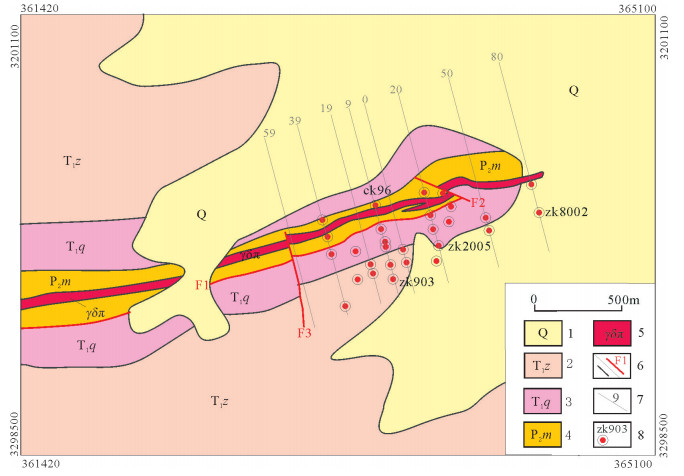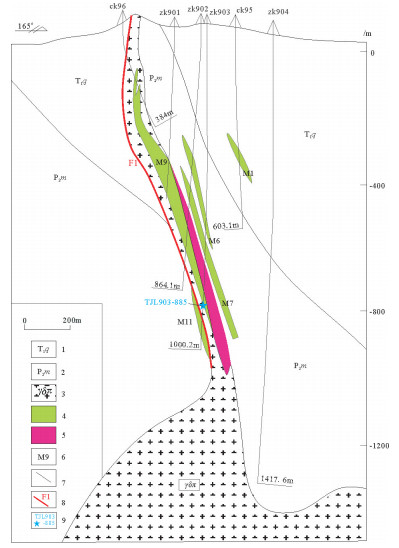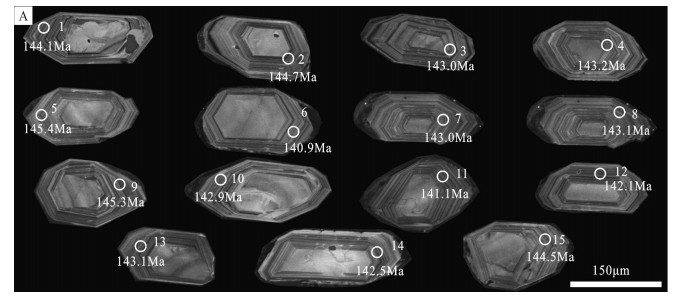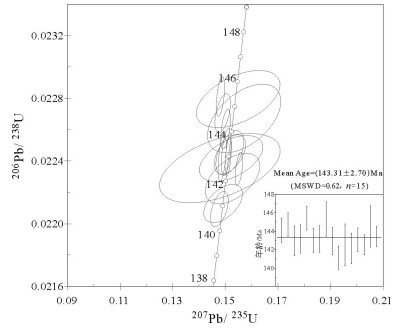Zircon U-Pb age of ore-forming magmatic rocks in the Tongjiangling coppertungsten deposit in the Jiurui ore concentration area and its significance
-
摘要:
通江岭铜钨矿区内矿体总体走向北东、倾向南东, 呈似层状、透镜状产出于花岗闪长斑岩与茅口组碳酸盐接触带附近, 矿石矿物以黄铜矿、白钨矿为主。区内成矿岩浆岩为花岗闪长斑岩, 其锆石U-Pb年龄为(143.31±2.70)Ma。通江岭矿区存在“上铜下钨铜”的矿化分带特征, 矿区石炭系、奥陶系碳酸盐岩与花岗闪长斑岩接触带或五通面、奥陶—志留系所形成的硅钙界面, 找钨潜能大。
Abstract:The orebodies in the Tongjiangling copper-tungsten mining area generally strike northeast and dip southeast, and occur as layers and lenses near the contact zone between the granodiorite porphyry and carbonate of the Maokou Formation. The ore minerals are mainly composed of chalcopyrite and scheelite. The metallogenic magmatic rocks in this area are granodiorite porphyry with zircon U-Pb age of (143.31+0.62) Ma. Mineralization zoning in the Tongjiangling mining area is characterized by "copper in the upper part and copper and tungsten in the lower part". The contact zone between Carboniferous and Ordovician carbonate rocks and granodiorite porphyry or the Wutong plane and the silica-calcium interface formed during Ordovician-Silurian in the mining area have a great potential for tungsten exploration.
-
Keywords:
- copper-tungsten deposit /
- granodiorite porphyry /
- zircon U-Pb /
- Tongjiangling /
- Jiurui
-
1. 引言
江西金属矿产素有南钨北铜的分布格局, 近年赣北地区新发现了大湖塘与朱溪两个世界级钨矿床, 彻底改变江西乃至世界钨资源的分布格局。朱溪原为热液脉型小铜矿, 断断续续采探十余年, 一直没有取得突破性进展。2009年, 江西省地勘基金以系列成矿理论为指导、按照“就矿找矿、以脉找体”思路, 揭示朱溪“上铜下钨”矿化分带模式, 在铜矿体的深部探获了延伸稳定(超2000 m)、厚度大(平均150 m余)、品位高(平均0.571%)的钨矿体, 矿床资源储量世界第一(Wang et al., 2014; 王先广等, 2015, 2018; 胡正华等, 2018a, 2018b), 目前矿床仍在勘查, 钨资源规模有望达到500万t。九瑞矿集区位于长江中下游Cu-Au-Mo(Fe)成矿带的转折端, 是中国铜矿大型资源基地, 查明铜资源储量313万t, 约占长江中下游铜总量的1/3。矿集区内勘查工作始于20世纪50年代, 开始以寻找铁矿为目的, 历经60余年的勘查总结出九瑞地区“上铁下铜(钼)”的矿化分带规律, 并发现了武山、城门、洋鸡山等一批大型铜金矿床。赣北地区钨矿存在3期成岩成矿作用, 自早至晚分别为: 160 Ma→150~145 Ma→135~125 Ma, 并且以150~145 Ma、135~125 Ma这两期为主(胡正华, 2018c)。大湖塘和朱溪、阳储岭钨矿床的成岩时代基本一致, 均为150~145 Ma(胡正华等, 2018a, 2018b, 2018c)。长江中下游成矿带鄂东南、宁镇、庐枞等矿集区亦发现了钨矿床(朱增青, 1987; 徐跃通等, 1992; 聂利青等, 2016)。通江岭铜钨矿床位于九瑞矿集区北侧, 是江西省地质勘查基金重点勘查项目, 近年通过系统勘查在矿区深部新发现了厚大的铜钨矿体, 成为九瑞矿集区新发现钨铜矿体的首个矿床。通江岭矿区深部钨铜矿体的发现, 极大丰富了九瑞矿集区找矿空间、找矿思路和找矿方向。通江岭铜钨矿床的研究程度较低, 仅进行了少量矿床地质特征的研究(胡正华等, 2018b), 本文拟通过对通江岭成矿岩浆岩年代学研究, 揭示矿床成矿岩浆岩形成时代, 为九瑞矿集区仍至长江中下游成矿带研究及下一步找矿方向提供建议。
2. 成矿背景
九瑞矿集区位于扬子板块南东缘襄广断裂与阳常断裂交汇处(图 1), 区内地层具有双层结构, 基底为新元古代双桥山群, 盖层从震旦纪至第四纪地层均有, 其中与成矿密切相关的地层主要为奥陶系与石炭系碳酸盐岩, 为区内主要赋矿地层。矿集区内褶皱与断裂构造发育, 褶皱为一系列轴向NE的褶皱带(王先广等, 2014); 断裂构造主要为NW—NNW和NE—NNE向两组, 这两组断裂构造的交汇部位是主要控岩控矿构造(翟裕生等, 1999; 包家宝等, 2002; 胡正华, 2015a)。矿集区内共出露31个岩体, 呈岩株、岩墙、岩脉状产出, 单个岩体出露面积为0.04~1.6 km2(翟裕生等, 1999)。岩株受NW—NNW向隐伏基底断裂控制, 呈等距状产出。岩脉受NE—NEE向断裂、NE向褶皱带、层间不整合面及层内薄弱面贯入式侵位产出, 自北至南发育6个岩浆岩带:即, 东雷湾—通江岭花岗闪长斑岩亚带、宝山—大桥花岗闪长斑岩亚带、宋家湾—武山花岗闪长斑岩亚带、大冲—丁家山石英闪长玢岩—花岗闪长斑岩亚带、城门山—十六公里花岗闪长斑岩—石英闪长玢岩亚带、沙河—狮子山花岗闪长斑岩—石英闪长玢岩亚带。区内矿产以铜、钼、金为主, 成矿岩浆岩均为高钾钙碱性Ⅰ型岩浆岩系列, 成岩时代集中于145 Ma左右(吴良士等, 1997; 李进文等, 2007; 蒋少涌等, 2008; 陈志洪等, 2011; 胡正华等, 2015a, 2018b, 2018c)。
![]() 图 1 长江中下游九瑞矿集区地质简图(据Pan et al., 1999修改)(A—长江中下游构造简图;B—九瑞矿集区地质简图)
图 1 长江中下游九瑞矿集区地质简图(据Pan et al., 1999修改)(A—长江中下游构造简图;B—九瑞矿集区地质简图)
1—奥陶系;2—志留系;3—泥盆—石炭系;4—二叠系;5—三叠系;6—第四系;7—岩体;8—地质界线/河流;9—矿床(点)位置及名称;10—城市位置及名称;11—矿集区;12—通江岭矿区位置Figure 1. Simplified geological map of the Jiurui ore concentration area in the middle-lower Yangtze River Valley (modified from Pan et al., 1999)(A-Structure diagram of the middle-lower Yangtze River Valley; B-Geological map of the Jiurui ore concentration area)
1-Ordovician; 2-Silurian; 3-Devonian, Carboniferous; 4-Permian; 5-Triassic; 6-Quaternary; 7-Lithesome; 8-Geological boundary/river; 9-Locations and names of deposits; 10-Locations and names of cities; 11-Ore concentration areas; 12-Location of Baoshan ore deposit3. 矿床地质
通江岭矿区位于九瑞地区龙泉古寺—牛头山背斜核部。区内出露的地层自老至新有中二叠统茅口组(P2m)、上二叠统龙潭组(P3l)、上二叠统长兴组(P3c)、下三叠统殷坑组(T1y)、下三叠统青龙组(T1q)、下三叠统周冲村组(T1z)(图 2), 地层总体走向北东, 以龙泉古寺—牛头山背斜核部为界。区内断裂构造发育, 根据走向可分为3组:北东向(F1、F2、F3)、北西向(F4)、近南北向(F5)断裂, 其中北东向F2断裂为区内主要控岩控矿构造。花岗闪长斑岩沿龙泉古寺—牛头山背斜核部与F2断裂呈NE向岩墙展布。
![]() 图 2 九瑞矿集区通江岭矿区地质简图1—第四系;2—下三叠统周冲村组;3—下三叠统青龙组;4—中二叠统茅口组;5—花岗闪长斑岩;6—断层及编号/地质界线;7—勘探线及其编号;8—钻孔及其编号Figure 2. Simplified geological map of the Tongjiangling ore deposit in the Jiurui ore concentration area1-Quaternary; 2-Lower Triassic Zhouchongcun Formation; 3-Lower Triassic Qinglong Formation; 4-Middle Permian Maokou Formation; 5-Granodiorite porphyry; 6-Fault and its number/ geological boundary; 7-Exploration line and its number; 8-Drill hole and its number
图 2 九瑞矿集区通江岭矿区地质简图1—第四系;2—下三叠统周冲村组;3—下三叠统青龙组;4—中二叠统茅口组;5—花岗闪长斑岩;6—断层及编号/地质界线;7—勘探线及其编号;8—钻孔及其编号Figure 2. Simplified geological map of the Tongjiangling ore deposit in the Jiurui ore concentration area1-Quaternary; 2-Lower Triassic Zhouchongcun Formation; 3-Lower Triassic Qinglong Formation; 4-Middle Permian Maokou Formation; 5-Granodiorite porphyry; 6-Fault and its number/ geological boundary; 7-Exploration line and its number; 8-Drill hole and its number通江岭铜钨矿由14条矿体(M1~M14)组成, 总体走向NEE, 倾向东, 呈似层状、透镜状产出于花岗闪长斑岩与茅口组(P2m)碳酸盐的内、外接触带(图 3)。矿石类型以铜矿石和铜钨矿石为主; 矿石矿物以白钨矿、黄铜矿为主, 脉石矿物长石、石英、绿泥石、高岭石、石榴子石、透辉石、透闪石、长石、石英、绿泥石、方解石等为主; 矿石构造以脉状、浸染状、块状为主; 矿石结构以结晶结构、交代结构和固溶体分离结构为主。区内矿化垂向上具有“上铜下钨铜”的分带模式, 上部矿化以铜矿化为主, 矿石矿物主要为黄铜矿, 脉石矿物主要为长石、石英、高岭土、绿泥石和石榴子石等矽卡岩矿物; 黄铜矿主要以脉状、浸染状、块状赋存于矽卡岩、矽卡岩化大理岩和蚀变花岗闪长斑岩中。下部以钨铜矿化为主, 矿石矿物以黄铜矿、白钨矿为主, 脉石矿物主要为石榴子石、透辉石、透闪石等矽卡岩矿物。
![]() 图 3 通江岭矿区9号勘探线剖面图1—下三叠统青龙组;2—中二叠统茅口组;3—花岗闪长斑岩;4—铜矿体;5—铜钨矿体;6—矿体及编号;7—地质界线;8—断层及编号;9—锆石U-Pb样采集位置及编号Figure 3. Geological section along No. 9 exploration line in the Tongjiangling minging area1-Lower Triassic Qinglong Formation; 2-Middle Permian Maokou Formation; 3-Granodiorite porphyry; 4-Copper orebody; 5-Coppertungsten orebody; 6-Orebody and its number; 7-Geological boundary; 8-Fault and its number
图 3 通江岭矿区9号勘探线剖面图1—下三叠统青龙组;2—中二叠统茅口组;3—花岗闪长斑岩;4—铜矿体;5—铜钨矿体;6—矿体及编号;7—地质界线;8—断层及编号;9—锆石U-Pb样采集位置及编号Figure 3. Geological section along No. 9 exploration line in the Tongjiangling minging area1-Lower Triassic Qinglong Formation; 2-Middle Permian Maokou Formation; 3-Granodiorite porphyry; 4-Copper orebody; 5-Coppertungsten orebody; 6-Orebody and its number; 7-Geological boundary; 8-Fault and its numberM9矿体为区内规模最大的铜钨矿体, 走向延伸超1200 m, 倾向延深超500 m, 真厚度10.43~27.66 m; Cu品位多介于0.45%~0.68%, 最高可达9.73%; WO3品位多介于0.05%~0.17%, 局部伴生Mo、Zn、Ag等, M9矿体矿石矿物以黄铜矿、白钨矿为主, 矿石构造以浸染状、细脉—网脉状为主。矿体具有“上铜下钨铜”的矿化分带特征。
4. 样品分析与测试结果
4.1 样品采集与测试
锆石U-Pb样品采自9线ZK0903孔885 m处M9矽卡岩矿体底板的花岗闪长斑岩(图 3)。花岗闪长斑岩(图 4)呈灰白-浅灰色, 斑状结构、块状构造, 斑晶(约64%)包括斜长石(约30%)、石英(约20%)、钾长石(约10%)、黑云母(约4%)。斜长石斑晶, 半自形板状, 粒径2~5 mm, 聚片双晶和卡钠复合双晶发育, 局部发育环带构造, 部分绢云母化; 石英斑晶, 他形粒状, 粒径2~3.5 mm。钾长石斑晶, 半自形粒状为主, 粒径2 mm左右, 常见高岭石化; 黑云母斑晶, 片状, 片径2~2.5 mm, 褐色, 多色性浅黄褐—黄褐色, 常见绿泥石化。基质(约36%)呈显微粒状结构, 由长英质及少量黑云母构成, 粒径一般为0.05~2 mm, 长石类可见绢云母化、高岭石化。
锆石U-Pb测年样品, 先破碎至60目, 采用浮选、磁选方法初步分离筛选出锆石, 然后在双目镜下将挑选色泽、晶形较好, 透明度较高的锆石颗粒, 用于锆石制靶, 拍摄阴极发光(CL)图像, 观察锆石内部结构, 选择环带清晰的岩浆岩锆石作为待测点。LA-ICP-MS锆石U-Pb年龄的测试工作在中国地质科学院矿产资源研究所LA-ICP-MS实验室完成, 测试仪器为Agilent 7500a型ICP-MS与激光剥蚀系统ComPex 102 Excimer。为确保LA-ICPMS锆石U-Pb年龄测试的精确度, 每测试5个点加测标样91500和NIST610一次, 并测量一个锆石Plesovice来确定仪器运行状态是否正常。锆石年龄测试结果用Isoplot 3.0程序处理, 具体分析步骤和数据处理过程参见文献(柳小明等, 2002)。
4.2 测试结果
花岗闪长斑岩内锆石无色, 透明, 主要呈长柱状, 部分锆石内见细小的包裹体及裂纹(图 5), 锆石粒径在50 μm×110 μm~90 μm×180 μm。阴极发光图像显示锆石成分含量比较均匀, 主要以振荡环带为主, 少量锆石发育扇状环带和无环带现象。为确保定年结果的准确性, 实验中选择具有明显振荡环带锆石的边缘进行测试。本样品中挑取的锆石长轴和短轴之比在2:1~4:3 (图 5), 测点Th、U含量分别为107~266 μg/g, 269~653 μg/g(表 1)。Th/U比值大多介于0.34~0.71 (表 1), 与岩浆锆石的特征相似(吴元保等, 2004)。经测定15个有效锆石测点的207Pb/235U、206Pb/238U分析结果在误差范围内基本一致, 206Pb/238U年龄的加权平均值为(143.31±2.70)Ma (MSWD=0.62, n=15)(表 1, 图 6)。
表 1 通江岭矿区花岗闪长斑岩LA-ICP-MS锆石U-Pb年龄分析结果Table 1. LA-ICP-MS zircon U-Pb age data of granodiorite porphyry in The Tongjiangling mining area
5. 讨论
5.1 成矿岩体及其成岩时代
通江岭矿区自花岗闪长斑岩体至茅口组碳酸盐岩具有绿泥石化-硅化-高岭土化(花岗闪长斑岩) →石榴子石-透辉石-透闪石矽卡岩→矽卡岩化化大理岩→大理岩蚀变分带, 区内黄铜矿、白钨矿物等矿石矿物主要呈细脉状、浸染状产出于花岗闪长岩与茅口组碳酸盐岩接触带的矽卡岩中, 部分以浸染状产出于蚀变花岗闪长斑岩中, 矿体垂向上自围岩至岩体(自浅至深)显示出“中温→中高温”的元素分带性, 即具有“上铜下钨铜”的矿化分带特征, 与典型的斑岩-矽卡岩型矿床的蚀变分带特征基本一致(王先广等, 2015; 唐菊兴等, 2017; 胡正华等, 2018c), 指示出花岗闪长斑岩为通江岭矿床的成矿岩浆岩, 矿床类型为斑岩-矽卡岩型。通江岭铜钨矿成矿花岗闪长斑岩锆石U-Pb年龄为(143.31±2.70) Ma(MSWD=0.62, n=15), 代表了成矿花岗闪长斑岩的成岩年龄。
5.2 找矿潜力剖析
长江中下游成矿带鄂东南、宁镇、庐枞等矿集区已发现钨矿体或钨矿化体的报道, 如鄂东南矿集区阳新阮家湾和傅家山(朱增青, 1987; 徐跃通等, 1992)、大冶龙角山等矽卡岩型钨铜钼矿床(朱增青, 1987); 宁镇矿集区谏壁发现过中型斑岩型钨、钼矿床(杨松生等, 1985; 马春等, 2003); 庐枞矿集区东顾山矽卡岩型钨多金属矿床(聂利青等, 2016)。聂利青等(2016)提出长江中下游成矿带除铁、铜外, 亦具有良好找钨前景。九瑞矿集区受长江断裂西段北西西向的鄂州—九江深断裂带上盘控制, 两端为北北东向的麻城—湘东、赣江断裂带截接制约, 并与瑞昌弧形构造东部的北东东向反S形褶皱与走向断裂以及北北西向张裂隙带复合, 形成一个以北西西向为主轴的菱形构造网络结点控制着内岩浆岩侵位以及矿床的分布(包家定等, 2002)。矿集区内存在“多层结构”赋矿模式, 即层状矽卡岩矿体赋存于奥陶系、石炭系、二叠系、三叠系碳酸盐岩地层, 以石炭系地层为主(王先广等, 2014; 胡正华等, 2015a)。近年, 赣北地区新发现的朱溪世界最大钨矿床、武宁县东坪超大型石脉型黑钨矿床均具有上铜下钨的分带特征。朱溪钨矿的成岩成矿时代为145 Ma左右(王先广等, 2015; 胡正华, 2018c), 主矿体赋存于花岗岩与黄龙组碳酸盐岩接触带的矽卡岩中。近年, 江西省地质勘查基金管理中心在九瑞矿集区武山、南港矿区边深部均已发现了似层状斑岩-矽卡岩型铜钨矿体, 主要赋存于黄龙组碳酸盐岩与成矿岩浆岩的接触带附近, 成矿岩体均为花岗闪长斑岩或石英斑岩, 成矿岩年龄均为145 Ma左右(胡正华等, 2015a); 并且垂向上均具有“上铜下钨铜”的矿化分带特征, 中武山矿区深部的矽卡岩型钨铜矿体中钨资源规模达到大型。上石炭统黄龙组碳酸盐岩是赣北地区矽卡岩型矿床的主要赋矿围岩, 通江岭铜钨矿区目前仅在二叠系碳酸盐岩与花岗闪长斑岩接触带发现了斑岩-矽卡岩型铜钨矿体。通江岭矿区ZK0903孔790.15 m处花岗斑岩与碳酸盐岩接触带的矽卡岩中, 发现真厚度十余米的铜(钨)矿体, Cu品位多介于0.45%~0.68%, 最高可达9.73%; WO3平均品位0.067%, 最高达0.17%。区内其他钻孔在矽卡岩中亦揭示了钨矿化现象, 进一步表明通江岭矿区深部具有发现厚大钨矿体的潜能, 尤其是在矿区深部石炭系、奥陶系碳酸盐岩与花岗闪长斑岩的接触带或五通面、奥陶—志留系所形成的硅钙界面, 找矿潜能大。
6. 结论
(1) 通江岭铜钨矿成矿岩浆岩为花岗闪长斑岩, 其锆石U-Pb年龄为(143.31±2.70) Ma (MSWD=0.62, n=15), 代表了成矿花岗闪长斑岩成岩年龄。
(2) 九瑞矿集区具有“上铜下钨铜”的矿化分带趋势, 通江岭矿区石炭系、奥陶系碳酸盐岩与花岗闪长斑岩接触带或五通面、奥陶—志留系所形成的硅钙界面, 找钨潜能大。
致谢: 野外样品采集过程中得到江西省地质调查研究院曾庆权高级工程师的帮助; 成文过程得到了中国地质科学院地球深部探测中心曹殿华的指导, 在此一并表示感谢。 -
图 1 长江中下游九瑞矿集区地质简图(据Pan et al., 1999修改)
(A—长江中下游构造简图;B—九瑞矿集区地质简图)
1—奥陶系;2—志留系;3—泥盆—石炭系;4—二叠系;5—三叠系;6—第四系;7—岩体;8—地质界线/河流;9—矿床(点)位置及名称;10—城市位置及名称;11—矿集区;12—通江岭矿区位置Figure 1. Simplified geological map of the Jiurui ore concentration area in the middle-lower Yangtze River Valley (modified from Pan et al., 1999)
(A-Structure diagram of the middle-lower Yangtze River Valley; B-Geological map of the Jiurui ore concentration area)
1-Ordovician; 2-Silurian; 3-Devonian, Carboniferous; 4-Permian; 5-Triassic; 6-Quaternary; 7-Lithesome; 8-Geological boundary/river; 9-Locations and names of deposits; 10-Locations and names of cities; 11-Ore concentration areas; 12-Location of Baoshan ore deposit图 2 九瑞矿集区通江岭矿区地质简图
1—第四系;2—下三叠统周冲村组;3—下三叠统青龙组;4—中二叠统茅口组;5—花岗闪长斑岩;6—断层及编号/地质界线;7—勘探线及其编号;8—钻孔及其编号
Figure 2. Simplified geological map of the Tongjiangling ore deposit in the Jiurui ore concentration area
1-Quaternary; 2-Lower Triassic Zhouchongcun Formation; 3-Lower Triassic Qinglong Formation; 4-Middle Permian Maokou Formation; 5-Granodiorite porphyry; 6-Fault and its number/ geological boundary; 7-Exploration line and its number; 8-Drill hole and its number
图 3 通江岭矿区9号勘探线剖面图
1—下三叠统青龙组;2—中二叠统茅口组;3—花岗闪长斑岩;4—铜矿体;5—铜钨矿体;6—矿体及编号;7—地质界线;8—断层及编号;9—锆石U-Pb样采集位置及编号
Figure 3. Geological section along No. 9 exploration line in the Tongjiangling minging area
1-Lower Triassic Qinglong Formation; 2-Middle Permian Maokou Formation; 3-Granodiorite porphyry; 4-Copper orebody; 5-Coppertungsten orebody; 6-Orebody and its number; 7-Geological boundary; 8-Fault and its number
表 1 通江岭矿区花岗闪长斑岩LA-ICP-MS锆石U-Pb年龄分析结果
Table 1 LA-ICP-MS zircon U-Pb age data of granodiorite porphyry in The Tongjiangling mining area

-
Bao Jiabao, Tang Shuqing, Yu Zhiqing. 2002. Geology of Jiangxi Copper Deposits[M]. Nanchang:Jiangxi Science Technology Press:3-15 (in Chinese).
Chen Zhihong, Xing Guangfu, Guo Kunyi, Zeng Yong, Kuang Fuxiang, He Zhenyu, Ke Xue, Yu Minggang, Zhao Xilin, Zhang Yong. 2011.Zircon U-Pb ages of ore bearing granitic bodies in Northern Jiujiang-Ruichang m etallogenic district of the mineralization Belt of the Middle-Lower Reaches of the Yangtze River, and its geological significance[J]. Acta Geologica Sinica, 85(7):1146-1158 (in Chinese).
Hu Zhenghua, Wang Xiangguang, Li Yongmin, Liu Shanbao, Zhang Jiajing, Chen Yuchuan, Zhang Fangrong, Zeng Qingquan, Jiang Jingming, Sha Min, Nie Longmin, Wang Yiyun, Lei Tianhao, Hu wenjie, Gong Liangxin, Xie Ruifeng, Wen Liangxian, Wu Shijin.2015a. Re-Os age of molybdenite from the Baoshan copper polymetallic deposit in the Jiurui ore concentration area along the middle-lower Yangtze River region and its geological significance[J]. Geology in China, 42 (2):585-596 (in Chinese). http://www.wanfangdata.com.cn/details/detail.do?_type=perio&id=zgdizhi201502017
Hu Zhenghua, Liu Dong, Liu Shangbao, Lang Xinghai, Zhang Jiajing, Chen Yuchuan, Shi Guanghai, Wang Yiyun, Lei Tianhao, Nei Longmin, Sha Min, Gong Liangxin, Liu Zhanqing. 2015b. The diagenetic and metallogenic age of Donggang molybdenum (tungsten) deposit and its significance, in Leping City, Jiangxi Province[J]. Journal of Chengdu University of Technology(Science Technology Edition), 42 (3):312-322 (in Chinese).
Hu Zhenghua, Lou Fasheng, Li Yongming, Wang Xianguang, Chen Jiangping, Zeng Qingquan, Wu Shijing, Nie Longmin, Gong Liangxin, Wen Liangxian, Liu Gaofeng, Li Qian, Yu Xi.2018a. Geochrology, geochemistry and petrogenesis of ore-related granite in the Dongping tungsten deposit in Wuning County, Jiangxi Province[J]. Earth Science, 43 (S1):243-263 (in Chinese). http://d.old.wanfangdata.com.cn/Periodical/dqkx2018z1022
Hu Zhenghua, Wang Xianguang, Chen Guohua, Yu Xi, Hu Langming, Huang Qiuyun.2018b.Characteristics of Tongjiangling copper-tungsten deposit in Jiangxi and its prospecting significance[J]. China Tungsten Industry, 33 (5):15-20 (in Chinese). http://www.wanfangdata.com.cn/details/detail.do?_type=perio&id=zgwy201805003
Hu Zhenghua.2018c. Tungsten polymetallic ore metallogenic law and metallogenic prognosis of Jiangxi in the southeast margin of Yangtze Block[R].Nanchang: Geological survey of Jiangxi Province (in Chinese).
Jiang Shaoyong, Li Liang, Zhu Bi. Ding Xin, JiangYaohui, Gu Lianxing, Ni Pei. 2008. Geochemical and Sr-Nd-Hf isotopic compositions of granodiorite from the Wushan copper deposit, Jiangxi Province and their implications for petrogenesis[J]. Acta Petrologica Sinica, 24 (8):1679-1690 (in Chinese). http://www.wanfangdata.com.cn/details/detail.do?_type=perio&id=ysxb98200808002
Li Jingwen, Li Xianhua, Pei Rongfu, Mei Yanxiong, Wang Wenlei, Qu Wenju, Huang Xiubao. 2007. Re-Os Age of molybdenite from the southern ore zone of the Wushan copper deposit, Jiangxi Province, and its geological significance[J]. Acta Geologica Sinica, 81 (6):801-807 (in Chinese). http://www.wanfangdata.com.cn/details/detail.do?_type=perio&id=dizhixb200706008
Liu Xiaoming, Gao Shan, Yuan Honglin, Hattendorf B, Gǘnther D, Chen Liang, Hu Shenghong. 2002. Analysis of 42 major and trace elements in glass standard reference materials by 193 nm LA-ICPMS[J]. Acta Petrologica Sinica, 18 (3):408-418 (in Chinese). http://www.wanfangdata.com.cn/details/detail.do?_type=perio&id=ysxb98200203017
Ma Chun, Wang Sujuan. 2003. Zhenjiang in jiangsu jianbi rock mass charac-teristics and molybdenum(tungsten) ore deposit types[J]. Jiangsu Geology, 27 (3):152-158 (in Chinese).
Man Fasheng, Wang Xiaosong. 1988. Study on the porphyry type isotopic geochronology of Yangchuling of tungsten and molybdenum deposit[J]. Mineral Resources and Geology, 2(4):61-67 (in Chinese).
Nie Liqing, Zhou Taofa, Fan Yu, Zhang Qianming, Zhang Ming, Wang Longhu, Ge Jing. 2016. First discovery of a tungsten deposit in north of Luzong orefield along Middle Lower Yangtze river valley metallogenic belt[J]. Mineral Deposits, 35(5):999-1010(in Chinese). http://www.wanfangdata.com.cn/details/detail.do?_type=perio&id=kcdz201605008
Pan Yuanming, Dong Ping. 1999. The lower Changjiang(Yangzi/Yangtze River) metallogenic belt, east central China:Intrusion and wall rock-hosted Cu-Fe-Au, Mo, Zn, Pb, Ag deposits[J]. Ore Geology Reviews, 15:177-242. doi: 10.1016/S0169-1368(99)00022-0
Tang Juxing, Wang Qin, Yang Huanhuan, Gao Xi, Zhang Zebin, Zou Bin. 2017. Mineralization, exploration and resource potential of porphyry-skarn-epithermal copper polymetallic deposits in Tibet[J].Acta Geoscientica Sinica, 38 (5):571-613 (in Chinese). http://www.wanfangdata.com.cn/details/detail.do?_type=perio&id=dqxb201705002
Wang Xianguang, Liu Jianguang, Zhao Si, Qiu Ping. 2014. New discovery of the Zhuxi Tungsten-copper deposit, Jiangxi Province[J]. Acta Geologica Sinica (English Edition). 88 (z2):119. http://www.wanfangdata.com.cn/details/detail.do?_type=perio&id=WFHYXW592970
Wang Xianguang, Liu Zhanqing, Liu Shanbao, Wang Chenghui, Liu Jianguang, Wan HaoZhang, Chen Guohua, Zhang De, Liu Xiaolin.2015. LA-ICP-MS Zircon U-Pb dating and petrologic geochemistry of fine grained granite from Zhuxi Cu-W deposit, Jiangxi Province and its geological significance[J]. Rock and Mineral Analysis, 34 (5):592-599 (in Chinese). http://www.wanfangdata.com.cn/details/detail.do?_type=perio&id=ykcs201505015
Wang Xianguang, Zhou Xianxu, Ma Zhenxing, Zhan Tianwei, Li Yongming, Xia Zhongzhi, Li Yanhong, Hu Langming, Zeng Jiaxi. 2014.Progresses and prospecting in the deep and periphery of the Wushan copper deposit in the Jiurui area[J].Journal of East China Institute of Technology(Natural Science), 37(4):379-386(in Chinese). http://www.wanfangdata.com.cn/details/detail.do?_type=perio&id=hddzxyxb201404005
Wang Xianguang, Hu Zhenghua. 2018. Technological innovation in prospecting the world's largest tungsten copper deposit in Zhuxi[J]. Shanghai Land & Resources, 39 (4):117-121 (in Chinese).. http://d.old.wanfangdata.com.cn/Periodical/shdz201804025
Wu Liangshi, Zou Xiaoqiu. 1997. Re-Os isotopic age study of the Chengmenshan copper deposit, Jiangxi Province[J]. Mineral Deposits, 16 (4):376-381 (in Chinese). http://en.cnki.com.cn/Article_en/CJFDTOTAL-KCDZ704.009.htm
Wu Yuanbao, Zheng Yongfei.2004.Geogenic Mineralogy of zircon and its restriction on U-Pb Age Interpretation[J].Chinese Science Bulletin, 49 (16):1589-1604 (in Chinese). doi: 10.1360/csb2004-49-16-1589
Xu Yutong, Zhang Zengqing, Qiao Lidao, Shu Quanan. 1992.Research of Fengshan copper gold field prospecting mineralogy[J]. Geology and Prospecting, (28):32-35 (in Chinese).
Yang Songsheng, Duan Jiacai, Ju Zaifu, He Jianguo.1985.Discusse of Jianbi tung-sten molybdenum deposit geological characteristics and formation mechanism[J].Geology and Prospecting, (8):20 -27 (in Chinese).
Yuan Jianqi, Zhu Shangqing, Zhai Yusheng.1984.Ore Deposit Geology[M].Wuhan:Geological College of Wuhan, 104-130(in Chinese).
Zhai Yusheng, Yao Shuzheng, Zhou Zonggui.1999. The Ore Field Structure of the Copper and Gold Deposits in the Middle and Lower Raches of the Yangtze River[M].Wuhan:China University of Geosciences Press, 1-195 (in Chinese).
Zhu Zeng Qing.1987.Analysis of scheelite deposit metallogenic characteristicsin Middle-Lower Yangtze River valley metallogenic belt[J].Jiangsu Geology, (3):8-11 (in Chinese).
包家宝, 汤树清, 余志庆. 2002.江西铜矿地质[M].南昌:江西科学技术出版社, 3-15. 陈志洪, 邢光福, 郭坤一, 曾勇, 匡福祥, 贺振宇, 柯学, 余明刚, 赵希林, 张勇.2011.长江中下游成矿带九瑞矿集区(北部)含矿岩体的锆石U-Pb定年及其地质意义[J].地质学报, 85 (7):1146-1158. http://d.old.wanfangdata.com.cn/Periodical/dizhixb201107008 胡正华, 王先广, 李永明, 刘善宝, 张家菁, 陈毓川, 张芳荣, 曾庆权, 蒋金明, 沙珉, 聂龙敏, 王艺云, 雷天浩, 胡文洁, 龚良信, 谢瑞丰, 文亮先, 吴施金.2015a.长江中下游九瑞矿集区宝山铜多金属矿床辉钼矿Re-Os测年及其地质意义[J].中国地质, 42(2):585-596. http://geochina.cgs.gov.cn/geochina/ch/reader/view_abstract.aspx?file_no=20150217&flag=1 胡正华, 刘栋, 刘善宝, 郎兴海, 张家菁, 陈毓川, 施光海, 王艺云, 雷天浩, 聂龙敏, 沙珉, 龚良信, 刘战庆.2015b.江西省乐平市塔前钼(钨)矿床成岩成矿时代及意义[J].成都理工大学学报(自然科学版), 42 (3):312-322. http://www.cnki.com.cn/Article/CJFDTOTAL-CDLG201503007.htm 胡正华, 楼法生, 李永明, 李吉明, 王先广, 陈建平, 曾庆权, 吴师金, 聂龙敏, 龚良信, 文亮先, 刘高峰, 李倩, 余希.2018a.江西武宁县东坪钨矿床中与成矿有关的岩浆岩年代学、地球化学及岩石成因[J].地球科学, 43 (S1):243-263. http://d.old.wanfangdata.com.cn/Periodical/dqkx2018z1022 胡正华, 王先广, 陈国华, 胡朗明, 黄秋芸.2018b.江西通江岭铜钨矿床特征及其找矿意义[J].中国钨业, 33 (5):15-20. http://d.old.wanfangdata.com.cn/Periodical/zgwy201805003 胡正华.2018c.扬子陆块东南缘江西段钨多金属矿成矿规律与成矿预测[R].南昌: 江西省地质调查研究院. 蒋少涌, 李亮, 朱碧, 丁昕, 姜耀辉, 顾连兴, 倪培.2008.江西武山铜矿区花岗闪长斑岩的地球化学和Sr-Nd-Hf同位素组成及成因探讨[J].岩石学报, 24 (8):1679-1690. http://d.old.wanfangdata.com.cn/Periodical/ysxb98200808002 李进文, 李旭辉, 裴荣富, 梅燕雄, 王永磊, 屈文俊, 黄修保, 臧文.2007.江西武山铜矿南矿带辉钼矿Re-Os同位素年龄及其地质意义[J].地质学报, 81 (6):801-807. doi: 10.3321/j.issn:0001-5717.2007.06.008 柳小明, 高山, 袁洪林, Bodo HATTENDORF, DetlefGUNTHER, 陈亮, 胡圣红.2002.193nm LA-ICP-MS对国际地质标准参考物质中42种主量和微量元素的分析[J].岩石学报, (3):408-418. http://www.wanfangdata.com.cn/details/detail.do?_type=perio&id=ysxb98200203017 马春, 王素娟.2003.江苏镇江谏壁岩体特征与铝(钨)矿床类型[J].江苏地质.27 (3):152-158. http://www.cnki.com.cn/Article/CJFDTotal-JSDZ200303004.htm 满发胜, 王小松.1988.阳储岭斑岩型钨钼矿床同位素地质年代学研究[J].矿产与地质, 2 (4):61-67. http://www.cnki.com.cn/Article/CJFDTotal-KCYD198804010.htm 聂利青, 周涛发, 范裕, 张千明, 张明, 汪龙虎, 葛靖.2016.长江中下游成矿带庐枞矿集区新发现钨多金属矿床[J].矿床地质.35(5):999-1010. http://d.old.wanfangdata.com.cn/Periodical/kcdz201605008 唐菊兴, 王勤, 杨欢欢, 高昕, 张泽斌, 邹兵.2017.西藏斑岩-矽卡岩-浅成低温热液铜多金属矿成矿作用、勘查方向与资源潜力[J].地球学报, 38 (5):571-613. http://d.old.wanfangdata.com.cn/Periodical/dqxb201705002 王先广, 刘战庆, 刘善宝, 王成辉, 刘建光, 万浩章, 陈国华, 张德, 刘小林.2015.江西朱溪铜钨矿细粒花岗岩LA-ICP-MS锆石U-Pb定年和岩石地球化学研究[J].岩矿测试, 34 (5):592-599. http://d.old.wanfangdata.com.cn/Periodical/ykcs201505015 王先广, 周贤旭, 马振兴, 詹天卫, 李永明, 夏中智, 李艳红, 胡朗明, 曾甲晰.2014.九瑞地区武山铜矿外围深部找矿进展与方向[J].东华理工大学学报, 37 (4):378-385. http://d.old.wanfangdata.com.cn/Periodical/hddzxyxb201404005 王先广, 胡正华.2018.江西省朱溪世界最大钨铜矿找矿科技创新[J].上海国土资源, , 39 (4):117-121. http://d.old.wanfangdata.com.cn/Conference/9493008 吴良士, 邹晓秋. 1997.江西城门山铜矿铼-锇同位素年龄研究[J].矿床地质, 16 (4):376-381. http://www.cnki.com.cn/Article/CJFDTotal-KCDZ704.009.htm 吴元保, 郑永飞.2004.锆石成因矿物学研究及其对U-Pb年龄解释的制约[J].科学通报, 49 (16):1589-1604. doi: 10.3321/j.issn:0023-074X.2004.16.002 徐跃通, 张曾清, 肖立道, 舒全安.1992.丰山金铜矿田找矿矿物学研究[J].地质与勘探, (28):32 -35. http://www.cnki.com.cn/Article/CJFDTotal-DZKT199201007.htm 杨松生, 段家才, 鞠在富, 何建国.1985.谏壁钨铝矿床地质特征和成因机制讨论[J].地质与勘探, (8):20-27. http://www.cnki.com.cn/Article/CJFDTotal-DZKT198508003.htm 袁见齐, 朱上庆, 翟裕生.1984.矿床学[M].武汉:武汉地质学院, 104-130. 翟裕生, 姚书振, 周宗桂.1999.长江中下游铜金矿床矿田构造[M].武汉:中国地质大学出版社, 1-195. 朱增青.1987.长江中下游矽卡岩型白钨矿床成矿特征浅析[J].江苏地质, (3):8-11. http://www.cnki.com.cn/Article/CJFDTotal-JSDZ198703001.htm -
期刊类型引用(8)
1. 王海,付海平,李永胜,钟福军,王颖,吉鸿杰,徐林,胡朗明,杨世彪. 江西通江岭铜(钨)矿床石榴子石和锆石LA-ICP-MS原位U-Pb定年及其地质意义. 地质学报. 2023(07): 2281-2292 .  百度学术
百度学术
2. 王先广,曹圣华,龚良信,胡正华,曹明轩,张德富,陈麒如. 江西钨锡多金属矿床成矿系列与找矿. 地球学报. 2023(05): 916-932 .  百度学术
百度学术
3. 高任,谢桂青,冯道水,纪云昊,钟浩,张磊. 江西武山铜矿区新发现钨矿(化)体特征和其成因——来自矿相学、白钨矿原位U-Pb年代学和元素地球化学的约束. 矿床地质. 2023(06): 1139-1158 .  百度学术
百度学术
4. 高任,谢桂青,查志强,童继中,樊涛,章平,罗建安. 江西城门山铜矿床伴生稀散金属矿化特征及其地质意义. 地质与勘探. 2022(03): 514-531 .  百度学术
百度学术
5. 毛景文,周涛发,谢桂青,袁峰,段超. 长江中下游地区成矿作用研究新进展和存在问题的思考. 矿床地质. 2020(04): 547-558 .  百度学术
百度学术
6. 毛景文,吴胜华,宋世伟,戴盼,谢桂青,苏蔷薇,刘鹏,王先广,余忠珍,陈祥云,唐维新. 江南世界级钨矿带:地质特征、成矿规律和矿床模型. 科学通报. 2020(33): 3746-3762 .  百度学术
百度学术
7. 胡正华,王先广,陈毓川,周卫,王彦媛,龚良信,杨舒钧. 江南钨矿带(江西段)成矿规律. 中国钨业. 2020(05): 10-19 .  百度学术
百度学术
8. 杨世文,楼法生,丁沛勋,张芳荣. 赣北中生代岩浆作用与钨成矿特征. 中国钨业. 2020(05): 53-60 .  百度学术
百度学术
其他类型引用(0)



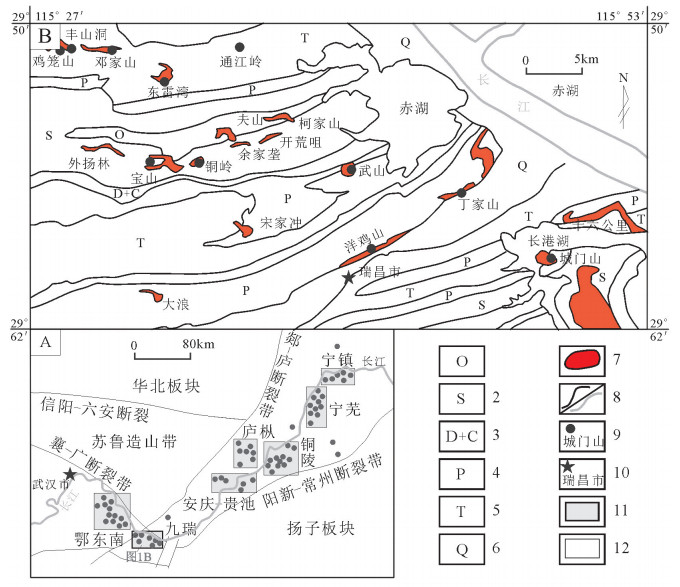
 下载:
下载:
